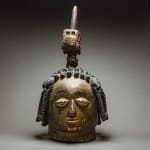Yoruba Wooden Polychrome Dance Mask, 20th Century AD
Tin, Wood
height 71.1 cm
height 28 in
height 28 in
LA.576
Further images
This magnificent mask is a colonial piece has been linked to the Yoruba of Nigeria. It is very large helmet model, and fashioned in the likeness of a woman’s head....
This magnificent mask is a colonial piece has been linked to the Yoruba of Nigeria. It is very large helmet model, and fashioned in the likeness of a woman’s head. The ground is brightly painted, with Ijebu-like half-closed eyes. The hair is exceptionally ornate, formed into plaits and ridges running along the head and alongside the face. The centre of the head is adorned with a tall spike that is decorated with a small tin model of a van.
The Yoruba peoples of Nigeria have what is probably the longest extant artistic tradition in Africa. The nation state is comprised of numerous subsections that were joined historically by the rise and collapse of the Ife (12th to 15th centuries) and Benin (13th to 19th centuries) polities. Each of the sub-kingdoms – including Oyo, Ijebu and smaller units towards the west – had their heyday, and are loosely united through language and culture, although they still retain a measure of independence in terms of their artistic traditions.
Access to the supernatural world is supervised by priests and spiritual intermediaries, who straddle the cosmological border between the tangible realm of the living (aye) and the invisible realm of the spirits and the hereafter (orun). The creator of the world is Olodumare – the source of all ase (life force) – and his spiritual minions include all manner of spirits, gods and ancestors who can be appealed to or appeased through human intermediaries. Most Yoruban artistic heritage is designed to thwart evil spirits, and to placate or honour those that bring good fortune to the populace.
This is evidently a dance mask of some sort, but it seems to be unique. The inclusion of the van is perplexing but is probably linked to an aspirational prayer – in the same manner of the Cargo Cults of the pacific. Such expensive western products would have been greatly desired but out of the reach of any but the most wealthy Africans. Alternately, it would be a mask designed to lampoon the colonials. Whatever its significance, this is a powerful and striking piece of African art.
The Yoruba peoples of Nigeria have what is probably the longest extant artistic tradition in Africa. The nation state is comprised of numerous subsections that were joined historically by the rise and collapse of the Ife (12th to 15th centuries) and Benin (13th to 19th centuries) polities. Each of the sub-kingdoms – including Oyo, Ijebu and smaller units towards the west – had their heyday, and are loosely united through language and culture, although they still retain a measure of independence in terms of their artistic traditions.
Access to the supernatural world is supervised by priests and spiritual intermediaries, who straddle the cosmological border between the tangible realm of the living (aye) and the invisible realm of the spirits and the hereafter (orun). The creator of the world is Olodumare – the source of all ase (life force) – and his spiritual minions include all manner of spirits, gods and ancestors who can be appealed to or appeased through human intermediaries. Most Yoruban artistic heritage is designed to thwart evil spirits, and to placate or honour those that bring good fortune to the populace.
This is evidently a dance mask of some sort, but it seems to be unique. The inclusion of the van is perplexing but is probably linked to an aspirational prayer – in the same manner of the Cargo Cults of the pacific. Such expensive western products would have been greatly desired but out of the reach of any but the most wealthy Africans. Alternately, it would be a mask designed to lampoon the colonials. Whatever its significance, this is a powerful and striking piece of African art.









